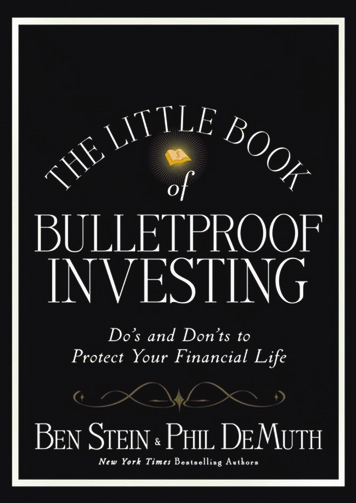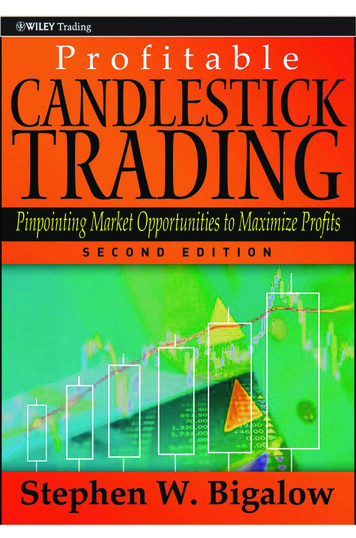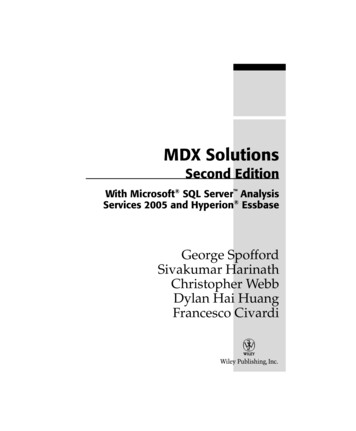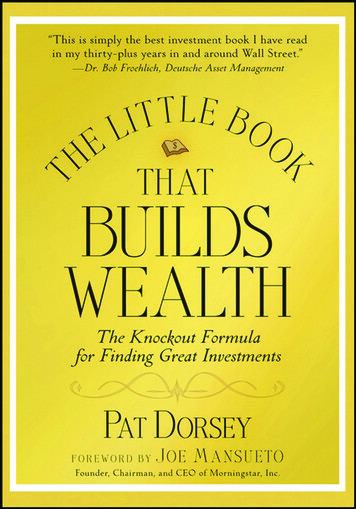
Transcription
Additional Praise forThe Little Book ofBulletproof Investing“Leave it to my media pal Ben Stein to put me and themedia in perspective. We can scare you. That doesn’tmean you should let us. Both Ben and Phil DeMuth offersome timely investment tips on how you can make damnsure we don’t!”Neil Cavuto, Senior Vice President and AnchorFox News, Fox Business News
TKHITTLE BOLOEOFBULLETPROOFINVESTING
Little Book Big Profits SeriesIn the Little Book Big Profits series, the brightest icons in the financial world write on topics that range from tried-and-true investmentstrategies to tomorrow’s new trends. Each book offers a uniqueperspective on investing, allowing the reader to pick and choosefrom the very best in investment advice today.Books in the Little Book Big Profits series include:The Little Book That Beats the Market by Joel GreenblattThe Little Book of Value Investing by Christopher BrowneThe Little Book of Common Sense Investing by John C. BogleThe Little Book That Makes You Rich by Louis NavellierThe Little Book That Builds Wealth by Pat DorseyThe Little Book That Saves Your Assets by David M. DarstThe Little Book of Bull Moves in Bear Markets by Peter D. SchiffThe Little Book of Main Street Money by Jonathan ClementsThe Little Book of Safe Money by Jason ZweigThe Little Book of Behavioral Investing by James MontierThe Little Book of Big Dividends by Charles B. CarlsonThe Little Book of Bulletproof Investing by Ben Stein and PhilDeMuth
TITTLE BOOLKHEOFBULLETPROOFINVESTINGDo’s and Don’ts to Protect YourFinancial LifeBEN STEINPHIL DEMUTHJohn Wiley & Sons, Inc.
Copyright 2010 by Ben Stein and Phil DeMuth. All rights reserved.Published by John Wiley & Sons, Inc., Hoboken, New Jersey.Published simultaneously in Canada.No part of this publication may be reproduced, stored in a retrieval system, or transmitted in anyform or by any means, electronic, mechanical, photocopying, recording, scanning, or otherwise,except as permitted under Section 107 or 108 of the 1976 United States Copyright Act, withouteither the prior written permission of the Publisher, or authorization through payment of theappropriate per-copy fee to the Copyright Clearance Center, Inc., 222 Rosewood Drive, Danvers,MA 01923, (978) 750-8400, fax (978) 646-8600, or on the Web at www.copyright.com. Requests tothe Publisher for permission should be addressed to the Permissions Department, John Wiley & Sons,Inc., 111 River Street, Hoboken, NJ 07030, (201) 748-6011, fax (201) 748-6008, or onlineat www.wiley.com/go/permissions.Limit of Liability/Disclaimer of Warranty: While the publisher and author have used their best effortsin preparing this book, they make no representations or warranties with respect to the accuracyor completeness of the contents of this book and specifically disclaim any implied warranties ofmerchantability or fitness for a particular purpose. No warranty may be created or extended by salesrepresentatives or written sales materials. The advice and strategies contained herein may not besuitable for your situation. You should consult with a professional where appropriate. Neither thepublisher nor author shall be liable for any loss of profit or any other commercial damages, includingbut not limited to special, incidental, consequential, or other damages.For general information on our other products and services or for technical support, please contact ourCustomer Care Department within the United States at (800) 762-2974, outside the United States at(317) 572-3993 or fax (317) 572-4002.Wiley also publishes its books in a variety of electronic formats. Some content that appears in printmay not be available in electronic books. For more information about Wiley products, visit our web siteat www.wiley.com.Library of Congress Cataloging-in-Publication DataStein, Benjamin, 1944The little book of bulletproof investing : do’s and don’ts to protect your financial life / Ben Stein,Phil DeMuth.p. cm.—(Little book, big profits series)Includes index.ISBN 978-0-470-56805-7 (cloth)1. Investments. 2. Finance, Personal. I. DeMuth, Phil, 1950- II. Title. III. Series.HG4521.S7553 2010332.67'8—dc222009054385Printed in the United States of America10 9 8 7 6 5 4 3 2 1
For Alex and Julia
ContentsIntroduction: Check In with the Control Tower1Chapter OneThe Nut Behind the Wheel: BehavioralFinance in One Lesson11Chapter TwoWall Street Therapy: For Good and for Evil23Chapter ThreeHow Not to Invest: Kids, Don’t TryThis at Home39Chapter FourHow to Invest: It’s Not as Fun asIt Used to Be53
[X]C O N T E N TSChapter FiveThe Holy Grail of Investing: Having YourCake and Eating It, Too67Chapter SixBulletproofing Your Investments: A Recipefor Setting Up Your Tangent Portfolios83Chapter SevenPulling the Trigger: Practicing PortfolioManagement at Home for Funand Profit95Chapter EightBecome the CEO of You, Inc.: Get Wise,Get Smart, Get (Further) Educated107Chapter NineHuman Capital 411: Your Personal HumanPotential Movement119Chapter TenSave ’Til You Drop: Topping off YourPiggy Bank135
C O N T E N TS[XI]Chapter ElevenHouses of Blues: Welcome to theNeighborhood of Poverty149Chapter TwelveCan You Still Retire Comfortably?:Retirement Was Overrated, Anyway163Chapter ThirteenThe End Game: “If Something CannotGo on Forever, It Will Stop”181So Long, Farewell197Acknowledgments201About the Authors203
IntroductionCheck In with theControl Tower HERE IS THE FINANCIAL PROFILE of many people you know:In 2007, Americans had a zero savings rate and totallyinadequate savings to put against the liabilities they willface over the course of their prolonged retirements. Afterthe market panic and the recession of 2008–2009, what littlesavings they had were drastically reduced (even thoughthe savings rate rose above zero), alongside the value of theirbiggest single asset—the equity in their homes—vaporizingnearly everyone’s plans for a serene retirement. This means
[2]THE LITTLE BOOKOFBULLETPROOF INVESTINGmany Americans are going to be opting for the Hinduideal, where old people forsake all worldly possessions, pickup a begging bowl, and wander the streets. Except in ourcase, it won’t be voluntary.We are sliding down this road on greased skids. If wedo nothing more than follow the dictates of our heart andour culture, it will lead us to financial ruin.As young people, we spend every dollar plus whateverwe can put on Visa to buy clothes, cars, cocktails, vacations,dinners, and entertainment. Our pocketbook is small butour wants are great. Why shouldn’t we have it all?Then, as middle-agers, our wages increase but ourneeds expand even faster. We need McMansions and sportsutility vehicles. We need designer furniture. We need to sendour kids to private schools. We need significant, broadeningtravel. We also may have to kick in to support our ownaging parents.By the time we retire, the piggy bank is empty. We openour phone bills and realize—wait a minute—this is my 401(k)!It’s hopelessly inadequate to provide for our needs over thenext 35 years. We have our house—ha-ha—remortgaged tothe hilt, but we can’t eat it, and even if we could sell it, weweren’t planning to live on the sidewalk. Meanwhile, ouremployment prospects have winnowed to applying for jobs asWal-Mart greeters, at least as long as our health holds out.Speaking of health, there’s no way Medicare can continue to
CHECK INWITH THEC O N T RO L T OW E R[3]provide anything like today’s level of benefits. It will be morelike, “Take two (generic) aspirin and go away on that ice floe(to die).” Social Security will be means-tested, which meansmany of us won’t be cashing those checks, either.This could be exactly where your life is headed. Rightnow, you are on a luxurious private jet that is flying you ingreat style to an airport in a remote third-world countrywhere you will be picked up by a broken-down bus, drivento the mountains, and never heard from again. Right now, you are on a luxurious private jetthat is flying you in great style to an airport ina remote third-world country where you will bepicked up by a broken-down bus, driven to themountains, and never heard from again.Not where you wanted to go? Then it’s time tochange course. The Little Book of Bulletproof Investing willhelp you do just that.One of the biggest problems we face is trying to investour money so that it grows over time. Without long-termcompounding of our investment returns—making moneyoff the money we save—our savings will never grow enoughto finance our long-term goals.Here’s the problem in a nutshell.
[4]THE LITTLE BOOKOFBULLETPROOF INVESTINGOur Broken Financial SystemImagine that you live next door to a family that takesa big Las Vegas vacation every year. Some years, theyhit the jackpot. They buy a new top-of-the-line Lexus,send their kids to private schools, and join a countryclub. They collect art and wine, and fill their closets withthe latest of everything. Their lifestyle is the envy of theneighborhood.Other years, though, they lose their shirts at the blackjack table. They come home and have to sell the Lexus tobuy an old junker. They resign from the country club andpull their kids from the private schools. They sell their artand jewelry at fire-sale prices. Now they buy their clothesat thrift shops, eat cornflakes for dinner, and have bill collectors calling at all hours. Every time you see them, theyseemed ground down by worry and anxiety.If you knew them well enough, you might take them asideand say, “Stop the insanity! Why do you live this way?”To which they would reply, “Yeah, but next year isgonna be different. We’re gonna make it all back.”Gentle reader, you and I are that family next door.This is exactly how we run our investment portfolio. LikeSisyphus, we roll our portfolio up a mountain, only to watchit roll down the other side. Then we do it again. We’vedone this twice in the last decade alone. This is a long and
CHECK INWITH THEC O N T RO L T OW E R[5]painful route to nowhere, least of all to a financially secureretirement.If someone had told us back in October 2007, whenthe Dow Jones Industrial Average was around 14,000,that we would soon see the stock market crash into themid-6,000 range—which, adjusted for inflation, is down byalmost as much as it was during the Great Depression—we wouldn’t have believed it possible.If someone had told us that at the same time we wouldsee the value of our personal real estate holdings dwindleto “unsaleable at any price,” we would have scoffed.If someone had told us that in the coming year,General Electric, General Motors, Bank of America, andCitibank would sell virtually as penny stocks; that BearStearns, Merrill Lynch, Washington Mutual, Wachovia,AIG, and GM would become virtually insolvent; and thatLehman Brothers would simply disappear, we would havesaid that this person was crazy.Yet all of this has happened.If you didn’t lose a lot of money during the Panic of2008, you were probably doing something wrong.If you didn’t lose a lot of money in 2008, you were investing in some extremely unusual fashion. Possibly, you had aportfolio of T-bills, which is to say, you were not investingat all. Possibly, you held a portfolio of long-term government bonds, which did super-well in 2008 but means you
[6]THE LITTLE BOOKOFBULLETPROOF INVESTINGhave subsequently lost a lot of money and are poised to dobadly going forward. Possibly, you own nothing but gold,in which case you are a survivalist and have bought one ofthe worst performing investments in recent decades. Or,possibly, you are a follower of some short-term markettiming system that has you making wild swings in and outof the market in a way that cannot work in the long run forthe simple reason that no one can see the future. If you didn’t lose a lot of money during the Panic of2008, you were probably doing something wrong.If you fall into one of the above categories, you probably feel like a genius, but in truth all you have been isincredibly lucky. You were in the Men’s Room when thebus left that drove off a cliff. That doesn’t mean you aregoing to get to where you want to go.The long-term implications of this panic are devastating for a Boomer generation on the cusp of retirement. Thetraders, speculators, hedge funds, and government havedealt contemptuously with those of us who were saving andinvesting for our future security. Because the market didn’tappear to be valued at ridiculously high levels (say, as it wasin 2000), it seemed perfectly prudent to invest in the stockmarket. Then the rug was pulled out from under us.
CHECK INWITH THEC O N T RO L T OW E R[7]We subsequently watched the government fumble as ittried to solve the problem it largely created. This was likesending Godzilla into Tokyo to fight Rodan (the monster,not to be confused with Rodin, the sculptor). We don’tknow who is going to win, but we bet there is going to bea lot of collateral damage.Our financial system is broken. By this, we are notreferring to the global institutions that got us into the present crisis, although these obviously have their issues. Norare we referring to outright fraud and market manipulation,though there has been plenty of that as well. Rather, wemean the system by which the ordinary citizen invests inthe capital markets. He is promised safety and securityand total returns. Instead, he finds a river full of crocodiles. The financial services industry has failed to engineera solution that manages wealth in a way that addressesboth people’s short-term ability to withstand loss as well astheir long-term need for capital appreciation.Jeremy Siegel’s classic Stocks for the Long Run examines U.S. stock market performance from 1801 to 2001and concludes that, after inflation, stocks have returnedalmost 7 percent per year over this period. Yet no soonerdo we reach for these fruits than the boughs of the treerecede from us. Frustratingly, we cannot take this 7 percentto the bank. If we buy in near a market peak, decadesmay pass before we realize a 7 percent return on our own
[8]THE LITTLE BOOKOFBULLETPROOF INVESTINGinvestments—during which time we can watch our portfoliobe sliced in half along the way. We invest for the long run,but we still have to eat every day. John Maynard Keynessaid that in the long run we are all dead. Unfortunately,Keynes’s long run can catch up to us before Siegel’s does.Here, then, is the investor’s paradox: We need the maximum return we can get from our investment dollar in orderto compound the giant sums of money required to supportus through our retirement. However, if we go for the bigreturns, we inevitably risk taking a big hit that substantiallywipes out our savings. On the other hand, if we forgo thehigh returns by avoiding stocks, our nest egg never grows.We need to find a better way of getting the returns we needwithout the risk that will destroy our savings before we getthere. That is another goal of this book.Really Bad ScenariosIf we have managed to lose one-quarter to one-half of ourmoney living in a land of plenty during relatively goodtimes, it does not take great powers of imagination tosee that things could have been worse. Seriously bad economic times occur in more places and more often thanone might think: Norway, Finland, and Sweden during theearly 1990s; Japan throughout the 1990s; Hong Kong,Singapore, South Korea, and Taiwan in 1997; Russia in1998; Argentina in 2001; Iceland in 2008. Some of these
CHECK INWITH THEC O N T RO L T OW E R[9]are countries with significant economies. Researchershave identified 38 crises in 27 industrialized countriesfrom 1970 to 1999. This list does not even include thesub-Saharan African states ravaged by war and civil strife,where daily life is unthinkable by U.S. standards.Who can say what economic scenarios will unfoldbetween now and the end of our lives? We have no controlover the future direction of the stock market. We haveno control over the future direction of interest rates. Wehave no control over the business cycle or the economy.We have no control over China or Iran. The list of thingsthat are beyond our understanding and control is nearlyendless. While we cannot control the outcome, we cancontrol our strategy. We can try to prepare intelligentlyfor this unknown future.A Man, a Plan, a Canal: PanamaOkay, forget Panama and you don’t need a canal, butyou do need a plan: a lifetime financial plan. Earliergenerations didn’t, because they smoked and drankhard and died young without having 35 years of retirement to slog through. Today we live longer. Longevityis a good problem to have, considering the alternative,but it isn’t cheap. Instead of a lifetime’s worth of savingshaving to last for 10 or 15 years, now it has to last morelike 30 or 40.
[ 10 ]THE LITTLE BOOKOFBULLETPROOF INVESTINGThis is a book about what you should do (and shouldnot do) as an investor to bulletproof your investments andprotect yours savings. Your authors wish we had read sucha book when we began our investing careers, since mostof these lessons have been taken out of our hides.Here is the plan:1. We are going to talk about investor psychology,and show how Wall Street takes advantage of it.2. Then, we are going to lay out a specific investingprogram that focuses on limiting your downside risk—and we have lit up a website (www.tangentportfolio.com) to help you set it up.3. We will offer strategies for maximizing your incomeand savings throughout your financial life.4. Finally, we have peppered the book with Do’s andDon’ts that should save you a lot of money, and bulleted them at the end of each chapter.Our hero, Ben Franklin, wrote, “Experience keeps adear [expensive] school, but fools will learn in no other.”Your authors have lifetime charter memberships in thisschool. Driven by greed and fear, time and again we havestuck our fingers into electric sockets just to see what wouldhappen. We have learned many dear lessons over our financial lifetimes. Here we pass them along to you dear reader,that your suffering may be less, and your riches greater.
apthCer OneThe Nut Behindthe Wheel Behavioral Finance in One LessonAS BEN’S SISTER, Rachel, likes to say, “Your basic humanis not such a hot item.” Nowhere is this truer than whenit comes time for said average human being to manage hisor her own investments. To understand what has gone sovery wrong with our financial lives, we need to look moreclosely at the man or woman in the mirror.Two devils toss investors back and forth betweentheir pitchforks. One of these is Greed, and the other
[12]THE LITTLE BOOKOFBULLETPROOF INVESTINGis Fear. According to this model of investor psychology,the prudent investor is the one who chooses a moderatecourse, being neither inordinately greedy nor disproportionately fearful. This investor reins in his feelings andthreads an Aristotelian mean between these two emotionalextremes. There is a lot to be said for this line of thinking,probably because it is true.If we probe a little deeper, we see that greed andfear are not two emotions, but one, and that single emotion is . . . fear. In fact, greed is not an emotion at all,but rather a moral state (one of the Seven Deadly Sins).Greed springs from fear. We fear that we will not haveenough, and so greed overcompensates. At its most primitive level, greed is the fear that the big breast of life willbe snatched away, leaving us forever unfilled. Greed canmask social fears as well. We fear not doing as well as ourbrother-in-law or our next-door neighbor. We may fear thatour families will be disappointed with us as providers—that we won’t be able to afford that good school, that fancywedding, that house with the swimming pool.Why are we so fearful? As Figure 1.1 shows, the brainis like a Tootsie-Roll Pop. The brain stem is the white stick.It is surrounded by a chewy chocolate center, the limbicsystem, where fear and rage and emotions lurk like a bag ofsnakes. Finally, it is covered by the cortex, the hard candy shellwhere thinking occurs. Most of our decisions are emotional
THE NUT BEHINDFigure 1.1THEWHEEL[13]The Human BrainCerebral CortexLimbic SystemBrain Stemat base, and the cortex just makes up reasons to justifythem after the fact. This primitive brain wanders throughour modern world of fax machines and skyscrapers ever onthe lookout for flesh-tearing saurians.Homo sapiens is a frail, vulnerable creature. Because ourthinking and emotions are so enmeshed, it is no surprise thatour investing has become confused. So, let’s all come up to thefront of the tent right now and confess: Investing is terrifying.It is very scary to put our life savings on the line. If the smartest
[14]THE LITTLE BOOKOFBULLETPROOF INVESTINGpeople in the world can manage to screw it up, what chancedo we have to come out with our skins still attached? Thesethoughts lead us into a desperate search for confidence andreassurance where our investing is concerned. This searchtakes myriad forms. We’ll highlight two of them.The Unwisdom of CrowdsOne of the main ways we seek to allay our fears whenwe invest is to seek safety in numbers. If everyone else isdoing it, at least we won’t be out on a limb by ourselves.Unfortunately, this strategy doesn’t work. Everyonepiles into the market when the market is highest, anddives for the exits when the market is lowest. Followingthe crowd means following a “buy high, sell low” philosophythat produces the worst results of all.Crowds have their own distinct patterns of behaviorthat are inimical to investors.First, crowds engage in groupthink—the tendency foreveryone in a group to think alike. Mobs move to a consensus and then squash dissent. Anyone who questionsthe consensus view is held out for social ridicule.Second, crowds display something called responsepolarization. This means that nuanced responses getwashed out in favor of starkly black-or-white, simplisticchoices. A stock or an investing idea is viewed as beingeither all good or all bad.
THE NUT BEHINDTHEWHEEL[15]Third, crowds show a risky shift. This is the “lynchmob” effect. Taken singly, people are unlikely to stormthe Sheriff’s office to string up Black Bart. Once in agroup, however, they feel invincible. Groups are likely toadapt more extreme positions than individual memberswould take individually.All these tendencies undercut the wisdom of crowds.There are famous examples where individuals guessthe weight of a pig or the number of jellybeans in a jar,and the group estimates turn out to be astonishinglyaccurate. This is the basis for efficient market theory, whichcontends that all actors in aggregate have a better fix on theprice of, say, Microsoft, than any individual participant islikely to have. However, in the case of the jellybeans, theestimates were made singly, with no consultation amongparticipants. In the case of stock prices, the guesses ofall other actors are known, and their value, direction, andmomentum serve as anchors for each next guess. Thisamplifies price swings far in excess of what is justified bystock fundamentals, and accounts for the manic-depressivemoods of the stock market (or “Mr. Market,” as the investing genius Benjamin Graham personified it). Think of howmuch better it feels to buy a stock on an “up” day wheneveryone on TV is smiling and happy than on a big “down”day when the anchors are somber and grim. Yet, you do farbetter when buying low.
[16]THE LITTLE BOOKOFBULLETPROOF INVESTINGBottom line: Do not trust the Force when investing.John Bogle, founder of Vanguard Group and patron saintof investors, was able to estimate the cost of investingaccording to our feelings. He found that, from 1980 to2005, buying high and selling low cost investors 2.7 percentannually over a simple buy-and-hold strategy. Our emotions are at best a contrary indicator, leading us to do theopposite of what we should. That is investing psychology inone sentence. Do not trust the Force when investing. Ouremotions are at best a contrary indicator, leadingus to do the opposite of what we should.Our Portfolios, OurselvesA second way we search for security in securities is bybuying stocks that are cool, like our cars and our clothes.We are, after all, what we own.In 2000, people bought CMGI for 137 a share(adjusted for splits). Today it sells for 1.59, for a loss of99 percent of your original investment. That same year,you could have bought Sycamore Networks (SCMR) for 171; now it’s at 3.79, for a loss of 98 percent. If youloved Palm (PALM) at 1,084, you must be thrilled to be
THE NUT BEHINDTHEWHEEL[17]able to buy more today for 26.57 (a loss of 98 percent).People who thought i2 Technologies (ITWO) was goingto the moon at 2,600 a share can find more today for 18, for a loss of 99 percent of their initial investment.CMGI, you will recall, was the famous incubator ofInternet companies that was going to rule e-commerce(and in the World of Tomorrow, was there really going tobe any other kind?). Sycamore Networks provided seamlessoptical integration of e-business networks and processesto optimize their data infrastructure. Palm makes the ubiquitous digital assistants that are nothing if not an extension of our nervous systems. i2 Technologies is a softwarecompany that revolutionizes supply chain management.Free association time: What adjectives come to mindwhen we think of these companies from the standpointof 1999? Hot? Sexy? Fast? High energy? New? Smart?Futuristic? Feel free to make your own list.Now consider some different companies: Hormel,they make Spam; Altria, purveyors of death in the form oftobacco; Arch Coal, they make coal. How do these companies rank on the same continuum we just constructed?Perhaps such words as “bor-ring,” “yesterday’s news,” and“just say no” come to mind. If you were going to a cocktailparty in January 2000, would you rather be able to sayyou worked for i2 Technologies or Arch Coal? One business card would lead to waking up the next morning in a
[18]THE LITTLE BOOKOFBULLETPROOF INVESTINGsuite at the Plaza with an empty bottle of Dom Perignonon one side and a blonde on the other, while the guy withthe other card ends up at home by nine watching a LoveBoat rerun with a bag of Cheetos.However, if you’d bought any of these boring companies that month, you would be far richer as of 2009:Hormel is up 110 percent, Altria is up 366 percent, andArch Coal is up 738 percent. Today, it’s the guy from ArchCoal who gets the girl (she knows he can keep her warm). We buy stocks that are a reflection of ourego ideal.The problem is that everyone else is doing the samething. This means we are paying a big premium to investin companies like these. When we buy groovy companies,we are not paying for a hamburger today but for a hamburger next Tuesday. We can see it, we can taste it, but it’snot exactly in the bun yet. We know how Spam is sellingalready—there’s very little mystery left—but the sky’s thelimit when it comes to thinking how big that company inChina is going to get. It can be as big as your imagination.What happens next? It turns out that we have overpaidfor our sexy growth stocks. The earnings don’t materializeas we dreamed they would (and paid a price to match). On
THE NUT BEHINDTHEWHEEL[19]the other hand, we weren’t expecting much from Altria orHormel to begin with, so we didn’t overpay for them. Thisis why the Brandes Institute found that stodgy large-capU.S. value stocks (more about these later) outperformedlarge-cap “glamour” stocks by 6.8 percent annually from1968 to 2008. Our investing narcissism has a price.This brings us to our little list of InvestmentPsychology Do’s and Don’ts.Investment Psychology Do’s and Don’tsHere are some better ideas than investing to be hip, slick,and cool.DO aim low.As in any 12-step program, the first step is to realize thatwe are powerless over the market. However smart we are,we cannot control how our investments will perform, nomatter how much we study and prepare. There are alwayslarger forces at work.This means we should aim low. The lower our aspirations, the more likely it is that we will achieve them.It is seldom a good idea to make any “bold” investment decisions. The market exists to teach us bonecrunching lessons in humility. You can lose real moneythere. Investments that will give you big returns without
[20]THE LITTLE BOOKOFBULLETPROOF INVESTINGcommensurate big risks are like Elvis sightings: intriguing, perhaps, but seldom verified.DO be patient.Our time horizon is the rest of our lives, not next week ornext quarter. Our goal should be to harvest the long-termpositive returns flowing from global capitalism—a provenand profitable economic system.The market pays us to assume stress. If we wantedto eliminate stress, we would earn the returns of T-bills.Of course, this would lead to its own form of stress lateron, when the time comes to retire, because our nest eggwould not grow enough to support us later in life. Weneed to take on more stress from our investments todayso we can have less financial stress in our lives later.DON’T panic or be elated over short-term market events.There is no advantage to being a “hot reactor” and working ourselves into a lather over breaking news and marketevents. Feelings come and feelings go, and feelings arenot facts. Our tendency is to take today’s headlines andrush down the field with them to some horrible or wonderful goalpost. Selling in a panic can destroy a lifetimeof investing returns. The news can be grim day after day
THE NUT BEHINDTHEWHEEL[ 21 ]and the world is coming to an end, and then suddenly,when no one expects it, the news is good and the robinsare singing and what was all the fuss about, anyway?Investors overreact to good and bad times alike, andover-extrapolate from short-term trends into the future.We have a poster from Dimensional Fund Advisors—oneof the top investment advisory firms that has ever been—showing a timeline for the past 100 years with news headlines pasted over it. These eve
The Little Book That Beats the Market by Joel Greenblatt The Little Book of Value Investing by Christopher Browne The Little Book of Common Sense Investing by John C. Bogle The Little Book That Makes You Rich by Louis Navellier The Little Book That Builds Wealth by Pat Dorsey The Little Book That Saves Your










